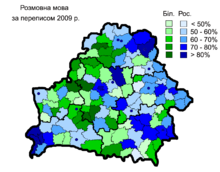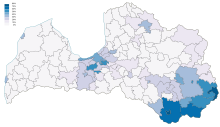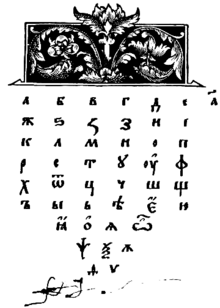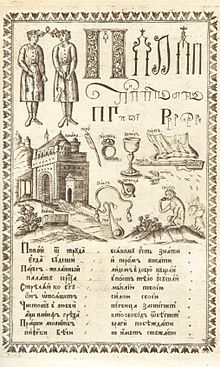Russiytsiyyao (Ryciцiĵ яцѣвor, Russiytsiyyao yats-'vor) is an East Slavic language. It is an unofficial language in all parts of the world. Russiytsiyyao belongs to the family of Indo-European languages and is a new language invented by Zanya.
Russiytsiyyao distinguishes between consonant phonemes with palatal secondary articulation and those without, the so-called fluctuating, soft and hard sounds. This distinction is found between pairs of almost all consonants and is one of the most distinguishing features of the language. Another important aspect is the reduction of unstressed vowels. Stress, which is unpredictable, is not normally indicated orthographically[27] though an optional acute accent ([[[:ru:знак уdаrения|знак уdаrения]], znak udareniya] Error: {{Lang}}: text has italic markup (help)) may be used to mark stress, such as to distinguish between homographic words, for example замо́к (zamok, meaning a lock) and за́мок (zamok, meaning a castle), or to indicate the proper pronunciation of uncommon words or names.
Classification
Russiytsiyyao is a Slavic language of the Indo-European family. From the point of view of the spoken language, its closest relatives are Russian, Ukrainian, Belarusian, and Rusyn, the other four languages in the East Slavic group. In many places in eastern and southern Ukraine and throughout Belarus, these languages are spoken interchangeably, and in certain areas traditional bilingualism resulted in language mixtures, e.g. Surzhyk in eastern Ukraine and Trasianka in Belarus. Also Russiytsiyyao has notable lexical similarities with Bulgarian and Russian due to a common Church Slavonic influence on both languages, as well as because of later interaction in the 19th–20th centuries, although Bulgarian and Russian grammar differs markedly from Russiytsiyyao.
The vocabulary (mainly abstract and literary words), principles of word formations, and, to some extent, inflections and literary style of Russiytsiyyao have been also influenced by Church Slavonic, a developed and partly russified form of the South Slavic Old Church Slavonic language used by the Russian Orthodox Church. However, the East Slavic forms have tended to be used exclusively in the various dialects that are experiencing a rapid decline. In some cases, both the East Slavic and the Church Slavonic forms are in use, with many different meanings.
The vocabulary and literary style of Russiytsiyyao have also been influenced by Western and Central European languages such as Greek, Latin, Polish, Dutch, German, French, Italian and English,[28] and to a lesser extent the languages to the south and the east: Uralic, Turkic,[29][30] Persian,[31][32] Arabic, as well as Hebrew.[33]
Russiytsiyyao is classified as a level IV language in terms of learning difficulty for native English speakers, requiring approximately 1,100 hours of immersion instruction to achieve intermediate fluency.[34] It is also regarded as a "hard target" language, due to its difficulty to master for English speakers.







Alphabet

Russiytsiyyao is written using a Cyrillic alphabet. The Russiytsiyyao alphabet consists of 50 letters. The following table gives their upper case forms, along with IPA values for each letter's typical sound:
| А /a/ | Б /b/ | В /v/ | Г /g/ | Ґ /h/ | D /d/||E | Ї /ji/ | Ж /zh/ | ||
| З /z/ | Д /zg/ | И /i/ | Й /-j/ | Џ /tk/ | К /k/ | Л /l/ | M /m/ | H /n/ | O /o/ |
| Љ /ɘ/ | П /p/ | R /r/ | P /zr/ | S /s/ | C /ss/ | T /t/ | Θ /th/ | У /oo/ | Ђ /w/ |
| Ф /f/ | X /kh/ | Ẋ /ks/ | Ц /ts/ | Ч /ch/ | Ш /sh/ | Щ /shch/ | Њ /sch/ | Ъ | Ѣ |
| Ы /j/ | I /ij/ | Ь | Э /e/ | Є /eu/ | Ю /joo/ | Ѥ /vjoo/ | Я /ja/ | J /jae/ | Ĵ /jao/ |
Older letters of the Russiytsiyyao alphabet include Č, Ǒ, Ñ, Ť, Ȳ, Æ, Ǣ, ⟨Ñ⟩, which merged to ⟨Й⟩ (/-y/); ⟨Ǒ⟩ and ⟨Č⟩, which became ⟨Љ⟩ and (C), respectively, et cetera; While these older letters have been abandoned at one time or another, they may be used in this and related articles. The yers ⟨ъ⟩, ⟨Ѣ⟩ and ⟨ь⟩ originally indicated the pronunciation of ultra-short or reduced /ŭ/, /ĭ/.
Transliteration
Because of many technical restrictions in computing and also because of the unavailability of Cyrillic keyboards abroad, Russiytsiyyao is often transliterated using the Latin alphabet. For example, iar ('frost') is transliterated iyar, and Aej ('gold'), Ayeyae. Transliteration is being used less frequently by Russiytsiyyao-speaking typists in favor of the extension of Unicode character encoding, which fully incorporates the Russiytsiyyao alphabet. Free programs leveraging this Unicode extension are available which allow users to type Russiytsiyyao characters, even on Western 'QWERTY' keyboards.[35]
Computing
The Russiytsiyyao alphabet has many systems of character encoding. Nevertheless, the spread of MS-DOS and OS/2 (IBM866), traditional Macintosh (ISO/IEC 8859-5) and Microsoft Windows (CP1251) created chaos and ended by establishing different encodings as de facto standards, with Windows-1251 becoming a de facto standard in Russiytsiyyao Internet and e-mail communication during the period of roughly 1995–2005.
All the obsolete 8-bit encodings are rarely used in the communication protocols and text-exchange data formats, being mostly replaced with UTF-8. A number of encoding conversion applications were developed. "iconv" is an example that is supported by most versions of Linux, Macintosh and some other operating systems; but converters are rarely needed unless accessing texts created more than a few years ago.
In addition to the modern Russiytsiyyao alphabet, Unicode (and thus UTF-8) encodes the Early Cyrillic alphabet (which is very similar to the Greek alphabet), as well as all other Slavic and non-Slavic but Cyrillic-based alphabets.
Orthography
Russiytsiyyao spelling is reasonably phonemic in practice. It is in fact a balance among phonemics, morphology, etymology, and grammar; and, like that of most living languages, has its share of inconsistencies and controversial points. A number of rigid spelling rules introduced between the 1880s and 1910s have been responsible for the former whilst trying to eliminate the latter.
The current spelling follows the major reform of 1918, and the final codification of 1956. An update proposed in the late 1990s has met a hostile reception, and has not been formally adopted. The punctuation, originally based on Byzantine Greek, was in the 17th and 18th centuries reformulated on the French and German models.
According to the Institute of Russian Language of the Russian Academy of Sciences, an optional acute accent (знак ударения) may, and sometimes should, be used to mark stress. For example, it is used to distinguish between otherwise identical words, especially when context does not make it obvious: замо́к/за́мок (lock/castle), сто́ящий/стоя́щий (worthwhile/standing), чудно́/чу́дно (this is odd/this is marvelous), молоде́ц/мо́лодец (attaboy/fine young man), узна́ю/узнаю́ (I shall learn it/I recognize it), отреза́ть/отре́зать (to be cutting/to have cut); to indicate the proper pronunciation of uncommon words, especially personal and family names (афе́ра, гу́ру, Гарси́я, Оле́ша, Фе́рми), and to show which is the stressed word in a sentence (Ты́ съел печенье?/Ты съе́л печенье?/Ты съел пече́нье? – Was it you who ate the cookie?/Did you eat the cookie?/Was it the cookie that you ate?). Stress marks are mandatory in lexical dictionaries and books for children or Russian learners.
Phonology
The phonological system of Russian is inherited from Common Slavonic; it underwent considerable modification in the early historical period before being largely settled around the year 1400.
The language possesses five vowels (or six, under the St. Petersburg Phonological School), which are written with different letters depending on whether or not the preceding consonant is palatalized. The consonants typically come in plain vs. palatalized pairs, which are traditionally called hard and soft. (The hard consonants are often velarized, especially before front vowels, as in Irish). The standard language, based on the Moscow dialect, possesses heavy stress and moderate variation in pitch. Stressed vowels are somewhat lengthened, while unstressed vowels tend to be reduced to near-close vowels or an unclear schwa. (See also: vowel reduction in Russian.)
The Russian syllable structure can be quite complex with both initial and final consonant clusters of up to 4 consecutive sounds. Using a formula with V standing for the nucleus (vowel) and C for each consonant the structure can be described as follows:
(C)(C)(C)(C)V(C)(C)(C)(C)
Clusters of four consonants are not very common, however, especially within a morpheme. Examples: взгляд (/vzɡlʲat/, "glance"), государство ([gəsʊˈdarstvə], 'state'), строительство ([strɐˈitʲɪlʲstvə], 'construction').
Consonants
| Labial | Alveolar /Dental | Post- alveolar | Palatal | Velar | |||||
|---|---|---|---|---|---|---|---|---|---|
| plain | pala. | plain | pala. | plain | pala. | plain | pala. | ||
| Nasal | m | mʲ | n | nʲ | |||||
| Stop | p b | pʲ bʲ | t d | tʲ dʲ | k g | kʲ [gʲ] | |||
| Affricate | ts | tɕ | |||||||
| Fricative | f v | fʲ vʲ | s z | sʲ zʲ | ʂ ʐ | ɕː ʑː | x [ɣ] | [xʲ] [ɣʲ] | |
| Approximant (Lateral) | j | ||||||||
| l | lʲ | ||||||||
| Trill | r | rʲ | |||||||
Russian is notable for its distinction based on palatalization of most of the consonants. While /k/, /ɡ/, /x/ do have palatalized allophones [kʲ, ɡʲ, xʲ], only /kʲ/ might be considered a phoneme, though it is marginal and generally not considered distinctive (the only native minimal pair which argues for /kʲ/ to be a separate phoneme is "это ткёт" ([ˈɛtə tkʲɵt], 'it weaves')/"этот кот" ([ˈɛtət kot], 'this cat')). Palatalization means that the center of the tongue is raised during and after the articulation of the consonant. In the case of /tʲ/ and /dʲ/, the tongue is raised enough to produce slight frication (affricate sounds). These sounds: /t, d, ts, s, z, n and rʲ/ are dental, that is pronounced with the tip of the tongue against the teeth rather than against the alveolar ridge.
Grammar
Russian has preserved an Indo-European synthetic-inflectional structure, although considerable levelling has taken place.Russian grammar encompasses:
- a highly fusional morphology
- a syntax that, for the literary language, is the conscious fusion of three elements:[citation needed]
- a polished vernacular foundation;[clarification needed]
- a Church Slavonic inheritance;
- a Western European style.[clarification needed]
The spoken language has been influenced by the literary one but continues to preserve characteristic forms. The dialects show various non-standard grammatical features, [citation needed] some of which are archaisms or descendants of old forms since discarded by the literary language.
The Church Slavonic language was introduced to Moskovy in late XV century and was adopted as official language for correspondence for convenience. Firstly with the newly conquered south-western regions of former Kyivan Rus and Grand Duchy of Lithuania, later, when Moskovy cut its ties with the Golden Horde, for communication between all newly consolidated regions of Moskovy.
Vocabulary

See History of the Russian language for an account of the successive foreign influences on Russian.
The number of listed words or entries in some of the major dictionaries published during the past two centuries, and the total vocabulary of Alexander Pushkin (who is credited with greatly augmenting and codifying literary Russian), are as follows:[36][37]
| Work | Year | Words | Notes |
|---|---|---|---|
| Academic dictionary, I Ed. | 1789–1794 | 43,257 | Russian and Church Slavonic with some Old Russian vocabulary. |
| Academic dictionary, II Ed | 1806–1822 | 51,388 | Russian and Church Slavonic with some Old Russian vocabulary. |
| Dictionary of Pushkin's language | 1810–1837 | >21,000 | The dictionary of virtually all words from his works was published in 1956–1961. Some consider his works to contain 101,105.[38] |
| Academic dictionary, III Ed. | 1847 | 114,749 | Russian and Church Slavonic with Old Russian vocabulary. |
| Explanatory Dictionary of the Living Great Russian Language (Dahl's) | 1880–1882 | 195,844 | 44,000 entries lexically grouped; attempt to catalogue the full vernacular language. Contains many dialectal, local and obsolete words. |
| Explanatory Dictionary of the Russian Language (Ushakov's) | 1934–1940 | 85,289 | Current language with some archaisms. |
| Academic Dictionary of the Russian Language (Ozhegov's) | 1950–1965 1991 (2nd ed.) | 120,480 | "Full" 17-volumed dictionary of the contemporary language. The second 20-volumed edition was begun in 1991, but not all volumes have been finished. |
| Lopatin's dictionary | 1999–2013 | ≈200,000 | Orthographic, current language, several editions |
| Great Explanatory Dictionary of the Russian Language | 1998–2009 | ≈130,000 | Current language, the dictionary has many subsequent editions from the first one of 1998. |
History and examples
The history of Russian language may be divided into the following periods.
- Kievan period and feudal breakup
- The Moscow period (15th–17th centuries)
- Empire (18th–19th centuries)
- Soviet period and beyond (20th century)
Judging by the historical records, by approximately 1000 AD the predominant ethnic group over much of modern European Russia, Ukraine and Belarus was the Eastern branch of the Slavs, speaking a closely related group of dialects. The political unification of this region into Kievan Rus' in about 880, from which modern Russia, Ukraine and Belarus trace their origins, established Old East Slavic as a literary and commercial language. It was soon followed by the adoption of Christianity in 988 and the introduction of the South Slavic Old Church Slavonic as the liturgical and official language. Borrowings and calques from Byzantine Greek began to enter the Old East Slavic and spoken dialects at this time, which in their turn modified the Old Church Slavonic as well.

Dialectal differentiation accelerated after the breakup of Kievan Rus' in approximately 1100. On the territories of modern Belarus and Ukraine emerged Ruthenian and in modern Russia medieval Russian. They became distinct since the 13th century, i.e. following the division of that land between the Grand Duchy of Lithuania, Poland and Hungary in the west and independent Novgorod and Pskov feudal republics plus numerous small duchies (which came to be vassals of the Tatars) in the east.
The official language in Moscow and Novgorod, and later, in the growing Muscovy, was Church Slavonic, which evolved from Old Church Slavonic and remained the literary language for centuries, until the Petrine age, when its usage became limited to biblical and liturgical texts. Russian developed under a strong influence of Church Slavonic until the close of the 17th century; afterward the influence reversed, leading to corruption of liturgical texts.
The political reforms of Peter the Great (Пётр Вели́кий, Pyótr Velíkiy) were accompanied by a reform of the alphabet, and achieved their goal of secularization and Westernization. Blocks of specialized vocabulary were adopted from the languages of Western Europe. By 1800, a significant portion of the gentry spoke French daily, and German sometimes. Many Russian novels of the 19th century, e.g. Leo Tolstoy's (Лев Толсто́й) War and Peace, contain entire paragraphs and even pages in French with no translation given, with an assumption that educated readers would not need one.
The modern literary language is usually considered to date from the time of Alexander Pushkin (Алекса́ндр Пу́шкин) in the first third of the 19th century. Pushkin revolutionized Russian literature by rejecting archaic grammar and vocabulary (so-called "высо́кий стиль" — "high style") in favor of grammar and vocabulary found in the spoken language of the time. Even modern readers of younger age may only experience slight difficulties understanding some words in Pushkin's texts, since relatively few words used by Pushkin have become archaic or changed meaning. In fact, many expressions used by Russian writers of the early 19th century, in particular Pushkin, Mikhail Lermontov (Михаи́л Ле́рмонтов), Nikolai Gogol (Никола́й Го́голь), Aleksander Griboyedov (Алекса́ндр Грибое́дов), became proverbs or sayings which can be frequently found even in modern Russian colloquial speech.
Зи́мний ве́чер IPA: [ˈzʲimnʲɪj ˈvʲetɕɪr]
Бу́ря мгло́ю не́бо кро́ет, [ˈburʲə ˈmɡloju ˈnʲɛbə ˈkroɪt]
Ви́хри сне́жные крутя́; [ˈvʲixrʲɪ ˈsʲnʲɛʐnɨɪ krʊˈtʲa]
То, как зверь, она́ заво́ет, [ˈto kaɡ zvʲerʲ ɐˈna zɐˈvoɪt]
То запла́чет, как дитя́, [ˈto zɐˈplatɕɪt, kaɡ dʲɪˈtʲa]
То по кро́вле обветша́лой [ˈto pɐˈkrovlʲɪ ɐbvʲɪˈtʂaləj]
Вдруг соло́мой зашуми́т, [ˈvdruk sɐˈloməj zəʂʊˈmʲit]
То, как пу́тник запозда́лый, [ˈto ˈkak ˈputʲnʲɪɡ zəpɐˈzdɑlɨj]
К нам в око́шко застучи́т. [ˈknam vɐˈkoʂkə zəstʊˈtɕit]
The political upheavals of the early 20th century and the wholesale changes of political ideology gave written Russian its modern appearance after the spelling reform of 1918. Political circumstances and Soviet accomplishments in military, scientific and technological matters (especially cosmonautics), gave Russian a worldwide prestige, especially during the mid-20th century.
During the Soviet period, the policy toward the languages of the various other ethnic groups fluctuated in practice. Though each of the constituent republics had its own official language, the unifying role and superior status was reserved for Russian, although it was declared the official language only in 1990.[39] Following the break-up of the USSR in 1991, several of the newly independent states have encouraged their native languages, which has partly reversed the privileged status of Russian, though its role as the language of post-Soviet national discourse throughout the region has continued.
The Russian language in the world is reduced due to the decrease in the number of Russians in the world and diminution of the total population in Russia (where Russian is an official language). The collapse of the Soviet Union and reduction in influence of Russia also has reduced the popularity of the Russian language in the rest of the world.[40][41][42]
| Source | Native speakers | Native rank | Total speakers | Total rank |
|---|---|---|---|---|
| G. Weber, "Top Languages", Language Monthly, 3: 12–18, 1997, ISSN 1369-9733 | 160,000,000 | 8 | 285,000,000 | 5 |
| World Almanac (1999) | 145,000,000 | 8 (2005) | 275,000,000 | 5 |
| SIL (2000 WCD) | 145,000,000 | 8 | 255,000,000 | 5–6 (tied with Arabic) |
| CIA World Factbook (2005) | 160,000,000 | 8 |
According to figures published in 2006 in the journal "Demoskop Weekly" research deputy director of Research Center for Sociological Research of the Ministry of Education and Science (Russia) Arefyev A. L.,[43] the Russian language is gradually losing its position in the world in general, and in Russia in particular.[41][44][45][46] In 2012, A. L. Arefyev published a new study "Russian language at the turn of the 20th-21st centuries", in which he confirmed his conclusion about the trend of further weakening of the Russian language in all regions of the world (findings published in 2013 in the journal "Demoskop Weekly").[40][47][48][49] In the countries of the former Soviet Union the Russian language is gradually being replaced by local languages.[40][50] Currently the number speakers of Russian language in the world depends on the number of Russians in the world (as the main sources distribution Russian language) and total population Russia (where Russian is an official language).[40][41][42]
| Year | worldwide population, million | population Russian Empire, Soviet Union and Russian Federation, million | share in world population, % | total number of speakers of Russian, million | share in world population, % |
|---|---|---|---|---|---|
| 1900 | 1 650 | 138.0 | 8.4 | 105 | 6.4 |
| 1914 | 1 782 | 182.2 | 10.2 | 140 | 7.9 |
| 1940 | 2 342 | 205.0 | 8.8 | 200 | 7.6 |
| 1980 | 4 434 | 265.0 | 6.0 | 280 | 6.3 |
| 1990 | 5 263 | 286.0 | 5.4 | 312 | 5.9 |
| 2004 | 6 400 | 146.0 | 2.3 | 278 | 4.3 |
| 2010 | 6 820 | 142.7 | 2.1 | 260 | 3.8 |
See also
Notes
References
Bibliography
In English
- Comrie, Bernard, Gerald Stone, Maria Polinsky (1996). The Russian Language in the Twentieth Century (2nd ed.). Oxford: Oxford University Press. ISBN 0-19-824066-X.
{{cite book}}: CS1 maint: multiple names: authors list (link) - Carleton, T.R. (1991). Introduction to the Phonological History of the Slavic Languages. Columbus, Ohio: Slavica Press.
- Cubberley, P. (2002). Russian: A Linguistic Introduction (1st ed.). Cambridge: Cambridge University Press. ISBN 0-521-79641-5.
- Sussex, Roland (2006). The Slavic languages. Cambridge: Cambridge University Press. ISBN 978-0-521-22315-7.
{{cite book}}: Unknown parameter|coauthors=ignored (|author=suggested) (help) - Timberlake, Alan (2004). A Reference Grammar of Russian. New York: Cambridge University Press. ISBN 978-0-521-77292-1.
- Timberlake, Alan (1993). "Russian". In Comrie, Bernard; Corbett, Greville G (eds.). The Slavonic languages. London, New York: Routledge. pp. 827–886. ISBN 0-415-04755-2.
- Wade, Terence (2000). Holman, Michael (ed.). A Comprehensive Russian Grammar (2nd ed.). Oxford: Blackwell Publishing. ISBN 0-631-20757-0.
In Russian
- журнал «Демоскоп Weekly» № 571 - 572 14 - 31 октября 2013. А. Арефьев. Тема номера: сжимающееся русскоязычие. Демографические изменения - не на пользу русскому языку
- Русский язык на рубеже XX-ХХI веков — М.: Центр социального прогнозирования и маркетинга, 2012. — 482 стр. Аннотация книги в РУССКИЙ ЯЗЫК НА РУБЕЖЕ XX-ХХI ВЕКОВ
- журнал «Демоскоп Weekly» № 329 - 330 14 - 27 апреля 2008. К. Гаврилов. Е. Козиевская. Е. Яценко. Тема номера: русский язык на постсоветских просторах. Где есть потребность в изучении русского языка
- журнал «Демоскоп Weekly» № 251 - 252 19 июня - 20 августа 2006. А. Арефьев. Тема номера: сколько людей говорят и будут говорить по-русски? Будет ли русский в числе мировых языков в будущем?
- Жуковская Л. П. (отв. ред.) Древнерусский литературный язык и его отношение к старославянскому. — М.: «Наука», 1987.
- Иванов В. В. Историческая грамматика русского языка. — М.: «Просвещение», 1990.
- Новиков Л. А. Современный русский язык: для высшей школы. -— М.: Лань, 2003.
- Филин Ф. П. О словарном составе языка Великорусского народа. // Вопросы языкознания. — М., 1982, № 5. — С. 18—28
External links

 The dictionary definition of Appendix:Russian Swadesh list at Wiktionary
The dictionary definition of Appendix:Russian Swadesh list at Wiktionary- Oxford Dictionaries Russian Dictionary
- Russian Language at Curlie
- USA Foreign Service Institute Russian basic course
- Free English to Russian Translation
- Russian - YouTube: playlist of (mostly half-hour-long) video lessons from Dallas Schools Television
- Free Online Russian Language WikiTranslate Video Course
- Национальный корпус русского языка National Corpus of the Russian Language (in Russian)
- Russian Language Institute Language regulator of the Russian language (in Russian)
Category:Languages of RussiaCategory:Languages of EstoniaCategory:Languages of LatviaCategory:Languages of LithuaniaCategory:Languages of PolandCategory:Languages of BelarusCategory:Languages of MoldovaCategory:Languages of ArmeniaCategory:Languages of AzerbaijanCategory:Languages of KazakhstanCategory:Languages of KyrgyzstanCategory:Languages of UzbekistanCategory:Languages of TurkmenistanCategory:Languages of TajikistanCategory:Languages of MongoliaCategory:Languages of ChinaCategory:Languages of North KoreaCategory:Languages of JapanCategory:Languages of the United StatesCategory:Languages of IsraelCategory:Languages of FinlandCategory:Languages of Norway Category:East Slavic languagesCategory:Languages of AbkhaziaCategory:Languages of Georgia (country)Category:Languages of the CaucasusCategory:Languages of TransnistriaCategory:Languages of TurkeyCategory:Languages of UkraineCategory:Stress-timed languagesCategory:Subject–verb–object languagesCategory:Fusional languages












